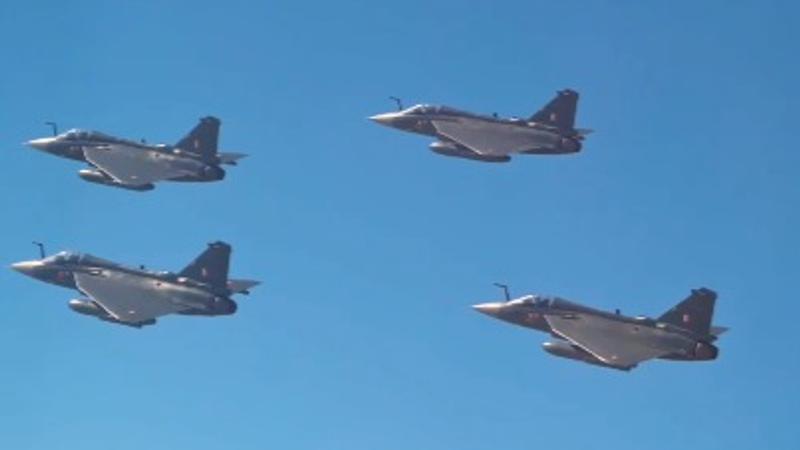Published 15:20 IST, January 25th 2024
Why Tejas Enjoys a Special Privilege Among All IAF Fighter Jets Taking Part in Republic Day Flypast
Here’s why Tejas, India's homegrown marvel, defies tradition at Republic Day, being the only single-engine fighter over Kartavya Path.

New Delhi: As India gears up to celebrate its 75th Republic Day, the Tejas, India's indigenously built light combat aircraft, is set to take to the skies in a spectacular and grand flypast and is among the over 50 aircraft slated to take part in the event.
What makes this special for Tejas is its unique privilege as the only single-engine fighter to be part of the impressive aerial display, breaking away from the tradition of featuring only double-engine fighters. This distinction brings to the forefront not just the honour bestowed upon Tejas but also the merit embedded in its powerful and reliable engine.

Why do we see only Double Engine Fighters over Kartavya Path?
The reluctance to include single-engine fighters in India's Republic Day parade has historically been rooted in the belief that double engines provide an extra layer of safety. The rationale behind this conventional wisdom lies in the redundancy offered by twin engines – if one fails, the other can potentially ensure the aircraft's safety, preventing a catastrophic crash.
However, Tejas challenges this norm, showcasing that its single-engine configuration is not a limitation but a testament to its reliability, capability, and standing among other fighter aircraft.

Tejas’ Debut over Kartavya Path
Back in 2017, Tejas made its maiden appearance in the Republic Day flypast, leading the fleet of fighter aircraft after a hiatus of two decades since Marut's participation in the 1980s and 90s.
The lightweight, supersonic, multi-role single-seat fighter, led by Group Captain Madhav Rangachari, flew in 'Vic' formation, highlighting its agility and prowess. Inducted into the Indian Air Force's 45 Squadron 'Flying Daggers' in July of the previous year, Tejas marked a significant milestone in India's pursuit of indigenous defence capabilities.

Tejas’ American F404 Heart and Impending Upgrade
Tejas' engine, a critical component of its success, has undergone a journey of development and innovation. Initially facing setbacks with the Kaveri jet engine program launched in 1986, Tejas found an interim solution in the General Electric F404-GE-F2J3 afterburning turbofan engine. Subsequently, upgraded General Electric F404-GE-IN20 engines have been powering Tejas variants since 2004. Adding to the intrigue, the F404 has FADEC, or Full Authority Digital Electronic Control – the latest aircraft ignition and engine control system that controls engine performance digitally, according to GE, making it more reliable in flight and less prone to crashing. This is probably one of the main enduring reasons why, from its very first day of induction, no Tejas has crashed to date.

Looking forward, the Tejas Mark 1A variant will continue to be powered by the F404 IN20 engine, while the heavier Tejas Mark 2 will feature the General Electric F414 INS6 engine. The recent agreement between General Electric and Hindustan Aeronautics Ltd (HAL) for the indigenous manufacturing of GE's F414 engine for Tejas Mk2 is also a groundbreaking development. It involves the transfer of critical jet engine technologies, marking a significant stride in India's quest for self-reliance in advanced combat jet engine technology.
This agreement breaks the traditional "technology denial regime," with only a few countries possessing the expertise to manufacture such advanced engines. The F414 engine, a stalwart in the US Navy's aircraft, has been in operation for over 30 years, powering renowned aircraft like the Boeing F/A-18E/F Super Hornet and Saab Gripen. India's successful collaboration with GE not only represents a leap forward in technological self-reliance but also strengthens defence ties between India and the United States.
India's Strategem with Tejas
Also, last year, PM Modi took a sortie in the LCA, becoming the first Prime Minister to do so. Tejas is India’s first completely indigenously designed and developed aircraft, and the genesis of the Tejas project dates back to the 80s, with its first flight during PM Atal Bihari Vajpayee’s tenure in 2001. However, it took another 15 years to get its initial operational clearance.

Today, India plans to acquire 97 more Tejas Mk1a fighters for 65,000 crore, in addition to the 83 previously planned in 2021 for 48,000 crore. Furthermore, there are plans for a Mk2 variant as well. The MK1A will feature a quadruple fly-by-wire with more multifunction displays, indigenous Uttam Radar, better avionics, and more additions to its already diverse arsenal.
Updated 15:20 IST, January 25th 2024




